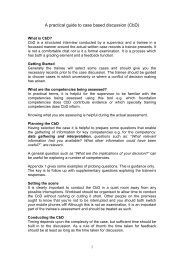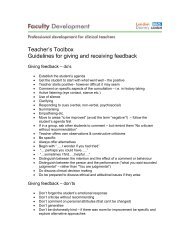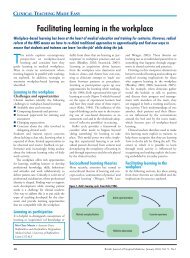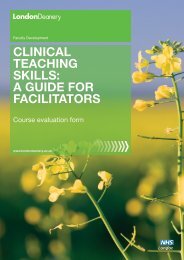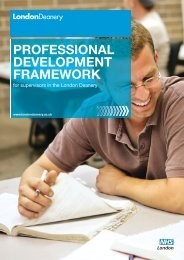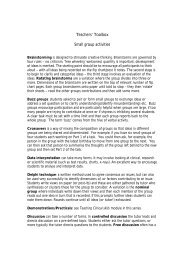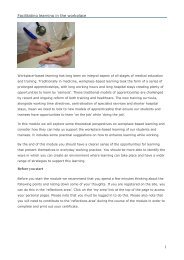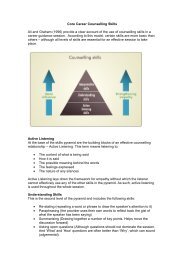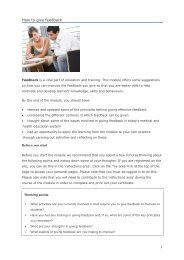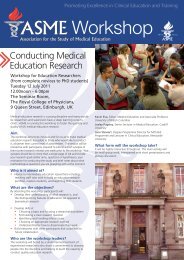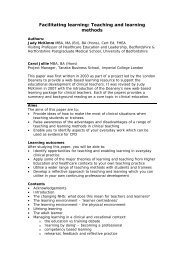Workplace- Based assessment: a GUIde For FacIlItators - Faculty ...
Workplace- Based assessment: a GUIde For FacIlItators - Faculty ...
Workplace- Based assessment: a GUIde For FacIlItators - Faculty ...
- No tags were found...
Create successful ePaper yourself
Turn your PDF publications into a flip-book with our unique Google optimized e-Paper software.
<strong>Faculty</strong> Development<strong>Workplace</strong>-<strong>Based</strong>Assessment:A GUIDE <strong>For</strong>FACILITATORSNotes for facilitatorswww.londondeanery.ac.uk
workplace-based <strong>assessment</strong>:A GUIDE FOR FACILITATORSNOTES FOR FACILITATORSIntroduction to THE NOTES FOR facilitatorsThis course has been designed to introduce the concept ofworkplace-based <strong>assessment</strong>s and their use in clinical teachingand learning. It provides an overview of educational theory thatunderpins their use, and examples from <strong>assessment</strong> tools currentlyused in foundation and specialty training. The course also providesan opportunity to consider how the use of these tools can beembedded in clinical teaching practice.About this guideThe purpose of this brief guide is to help you facilitate theworkplace-based <strong>assessment</strong> workshops. Contained within itshould be all the information you need to run the workshop on theday. The notes contain copies of the slides that are provided withthe course. The slides and notes are suggested approaches tosessions. However, you may decide not to use some of the slidesand develop your own slides or activities instead.PreparationPrior to running their own course it is recommended that facilitatorsattend a workshop as an observer, and during that day annotate acopy of this guide. Ideally, this course is delivered by two facilitatorsworking together throughout the day, although it is possible for thecourse to be delivered by one facilitator.The facilitator roleIt is essential that this role is one of facilitation and not that of alecturer. It is not essential to have expert knowledge of all aspectsof workplace-based <strong>assessment</strong>s.What is essential in a facilitator of this workshop are the following:• A robust understanding of workplace-based <strong>assessment</strong>s, whythey are used and the issues surrounding their use.• The ability to draw effectively on the experience withinthe group in order to make full use of the knowledge andunderstanding that different participants bring to the workshop.• The ability to present clearly the different activities containedwithin the workshop and manage the time effectively so thatthe necessary material is covered.• The confidence, if necessary, to challenge participants if theyare unduly cynical about educational supervision workplacebased<strong>assessment</strong>s or about wider changes in medicaleducation.AttendanceA minimum of 80% attendance at short courses is compulsory.This guide should also be seen as a ‘starter for 10’ – a way ofgetting going. But it’s not intended to be narrowly prescriptive.Workshop facilitators will probably have their own examples frompractice which will be useful to the groups they work with.The NHS Institute for Innovation and Improvement has developedtwo guides that can be used in conjunction with the facilitators’notes to help you think about how you would like to deliver thiscourse and how you may adapt your delivery after you have runthe course several times. ‘A Handy Guide to Facilitation’ providesguidance on facilitating groups and workshops. ‘The Facilitators’Tool Kit’ contains ‘tools, techniques and tips’ for those who arenew to facilitation (NHS Institute for Innovation and Improvement2009a,b).Both guides can be accessed via the following link:www.institute.nhs.uk/fundamentalsLondon Deanery <strong>Workplace</strong>-<strong>Based</strong> Assessment2
workplace-based <strong>assessment</strong>:A GUIDE FOR FACILITATORSNOTES FOR FACILITATORSThe coursePurposeThis course has been developed to consider the use of workplacebased<strong>assessment</strong>s (WPBAs) in regular clinical training andpractice. WPBAs were introduced with the Foundation Programmein 2005 and have subsequently been adopted by all specialtycurricula. They are now an integral part of the training reality, butthere is vast variation in how they are being used. This courseprovides a framework to consider the purposes and practicalitiesof using workplace-based training and <strong>assessment</strong> tools. Thereis an overview session to start with, looking at why we assess,what we should be assessing, how <strong>assessment</strong> can drive learningand how integral feedback is to the <strong>assessment</strong> process. Threeworkshops follow looking at the central <strong>assessment</strong> tools ofclinical evaluation exercise (CEX), 360º appraisal and case-baseddiscussion (CBD). These three <strong>assessment</strong> tools are used inthe Foundation Programme and variations on these tools aredeveloped in specialty training. The focus of the workshops is theprinciple of using <strong>assessment</strong> to train, but inevitably participantswill benefit from the exercises designed to develop workingknowledge of the tools. The course ends with a session looking at‘Taking it back to practice’, where participants consider how theywill embed the tools into their everyday work.<strong>For</strong>matThe course uses a variety of learning modes. Participants will takepart in workshops and discussion groups, and will assess videosusing the WPBA tools and providing feedback.Course ObjectivesBy the end of this course participants will have:• described the role of the WPBAs in postgraduate educationand training• distinguished <strong>assessment</strong> from training and summative<strong>assessment</strong> from formative <strong>assessment</strong>• placed the WPBAs into the framework of workplace-basedtraining and development• analysed three WPBA tools for their utility in developing clinicalskills, knowledge and behaviour in the workplace• identified the techniques used in effective appraisal interviews.• provided feedback to trainees within a multi-source feedback(MSF) appraisal conversation• structured a case-based discussion with a colleague to exploreor to reflect on an area of clinical practice• considered the role of workplace-based learning and how bestto facilitate learning as clinical educators• planned opportunities to support and implement, workplacebasedlearning and <strong>assessment</strong> within clinicians’ ownworkplace contexts.PracticalitiesPreparationIn information sent to participants before the course, ask them totry to bring along a copy of an anonymised record of one of theirown recent clinical encounters. The record will be used as thebasis for a peer-to-peer case-based discussion, exploring clinicalreasoning, diagnosis, decision making and management. Ideally,the case should have presented the participant with a moderatechallenge of some sort: not routine, but not an impossible patientor really tricky problem either.What to do on the dayIf the workshop is being run locally (at a trust) as opposed tocentrally (at the Deanery), it is a good idea to have researchedlocal information about who the educational supervisors cancontact if they have particular problems with trainees. <strong>For</strong> example,you might want to know the names of the Directors of MedicalEducation, Foundation Programme Training Director, etc.It is useful to arrange for packs to be made available to eachparticipant on the day with copies of relevant materials (e.g. thetimetable for the day, relevant handouts, slides and evaluationforms). If you decide to use videos or links from the internet, makesure that supporting equipment will be available and working. Itmay also be useful to have name tags for each participant.Facilitators should get there at least 30 minutes before the firstsession is due to begin. You need to check that the room has beenarranged appropriately (i.e. in a way that allows for small groupdiscussion) and that the audiovisual aids are working. Make surethere is plenty of paper on the flipchart and marker pens that work.Also draw out on a piece of plain paper the arrangement of tables/chairs, so that you can quickly do a seating plan to help you recallparticipants’ names. Provide a brief overview of the day (see page4 for a suggested programme).London Deanery <strong>Workplace</strong>-<strong>Based</strong> Assessment3
workplace-based <strong>assessment</strong>:A GUIDE FOR FACILITATORSOne-Day CourseProgramme09.30 Session 1: Introductions09.45 Session 2: <strong>Workplace</strong>-based <strong>assessment</strong> – an overview10.45 Coffee11.00 Session 3: Clinical skills12.00 Session 4: Multi-source feedback tools13.00 Lunch13.45 Session 5: Case-based discussion15.00 Tea15.15 Session 6: Taking it back16.30 CloseLondon Deanery <strong>Workplace</strong>-<strong>Based</strong> Assessment4
workplace-based <strong>assessment</strong>:A GUIDE FOR FACILITATORSNOTES FOR FACILITATORSPut up your first slide showing the title of the day.SLIDE 2: Course objectives.Slide 1: <strong>Workplace</strong>-based <strong>assessment</strong>.SESSION 1:9.30–9.45 IntroductionsThe function of this initial session is to set the scene for the day sothat participants are clear about the day’s objectives.Start by welcoming everybody.If people have seated themselves far from the front in tiny clusters,politely ask them to move, because you will be having small groupdiscussions during the day. Try to arrange equal-sized groups, ineven numbers, so that pairs can be formed easily later on.Introduce yourself briefly, giving your name, role and anyother immediately relevant background information. Provide abrief overview of the day (see previous page for a suggestedprogramme). Ask the participants to introduce themselves and toprovide one outcome they would like to achieve by the end of theday or course. This focuses their minds and enables the facilitatorsto ensure that expectations are met. If someone expresses adesire to cover something that is not covered by the course, thenit is best to say so upfront and to direct them to a more suitableresource or course. It may be that the facilitator can speak to theindividual during one of the breaks if they have relevant experienceor knowledge.Briefly discussing the learning objectives listed above is animportant way to start the course, as participants will be able tosee what it is they will be involved in doing during the sessionsand what skills they will have demonstrated by the completion ofthe courses.It is important to outline the limitations of the day at the outset.Many groups will consist of participants from a multitude ofspecialties, each with their own curriculum and Royal College.In a day it is impossible to cover all of the individual details fromeach specialty. It is important to stress that this is not a lectureon the various types of WPBA, but rather a workshop to look athow we can use the tools we have been given to develop traineeproficiency as best we can.Explain the structure of the day to the participants. First, thetheoretical basis of to WPBAs will be explored. This will be followedby three sessions exploring different types of WPBA. Each of thesessions offers an opportunity for participants to examine theprinciples of the <strong>assessment</strong> tool under consideration. They alsoinclude activities during which people will be asked to assessa trainee or a colleague using the requisite tool. In this way it ishoped that participants will see the educational and developmentpotential of the paperwork. The final session will provide anopportunity for participants to think about how they can implementWPBAs where they work.London Deanery <strong>Workplace</strong>-<strong>Based</strong> Assessment5
workplace-based <strong>assessment</strong>:A GUIDE FOR FACILITATORSNOTES FOR FACILITATORSSession 2:09.45–10.45 <strong>Workplace</strong>-based Assessments –AN OVERVIEWThe purpose of this session is to ensure that participantsunderstand the role of the WPBAs in postgraduate training, andare able to distinguish <strong>assessment</strong> from training, summative<strong>assessment</strong> from formative <strong>assessment</strong>, and place WPBAs intothe framework of workplace-based training and development.SLIDE 3: <strong>Workplace</strong>-based <strong>assessment</strong>s.ActivityIt is a good idea to start such a session with an activity to getpeople talking to each other. This is also an opportunity for peopleto register and discuss their frustrations at using the systemto date.One approach to doing so is to ask the group to split into smallergroups of four or five. Ask them to discuss their experiences ofusing WPBAs, as a training programme director (TPD), educationsupervisor, clinical supervisor, trainer or trainee. Give themabout 10–15 minutes for this, depending on how they seem tobe interacting. Then collate their responses on a flipchart. Youmay wish to divide the flipchart in half and put challenges andconstraints on one side and opportunities on the other. If the groupis very negative, try to suggest an opportunity from their challenge.<strong>For</strong> example, ‘I don’t have time to do this’ is a frequent challenge.An opportunity could be to define a 10-minute slot where a traineecould be observed in clinic.An alternative approach that can be used to get people talking is toask the groups to write their ideas on flipchart paper. After 10–15minutes ask participants to display their flipchart paper on thetables or walls and ask everyone to walk around looking at eachother’s work. Draw the activity to a close with a plenary discussionof the main points raised.This is a pivotal session, as it is important to:• bring out the grumbles early• define what is within our power to change or address• discuss the alternative to not engaging with the system(no training)• further define objectives for the day.Ask what the biggest challenge is.Share with the participants what trainees say are thechallenges for them.London Deanery <strong>Workplace</strong>-<strong>Based</strong> Assessment6
workplace-based <strong>assessment</strong>:A GUIDE FOR FACILITATORSNOTES FOR FACILITATORSSLIDE 4: Trainee-reported challenges.SLIDE 5: Learning in postgraduate training.At this point it is also useful to discuss how organisationaland cultural factors in the workplace, such as approach tomanagement and teamwork, can influence learning. However, ifparticipants are very negative about these challenges, you mayneed to make a show of drawing a line under what you havediscussed so far. Stress that they have been desciribing the pastbut that the day is designed to address some of the issues raisedso that the future works better.Say, ‘Let’s take a step back…’, and then ask them how theylearned in postgraduate training. Relate their responses to the mainareas of professional learning and development.This discussion is designed to show them that the ways theylearned are valued and built upon within the WPBAs; that theknowledge, skills, behaviours and attitudes we are encouragingtoday are the same ones we have always encouraged.Once the group has warmed up from the last activity it is goodto ask a series of key questions about <strong>assessment</strong>. The first onewould be ‘Why do we assess?’ Ask them why they want to assesstheir trainees – what is the point of it? Get them to answer thisen masse.London Deanery <strong>Workplace</strong>-<strong>Based</strong> Assessment7
workplace-based <strong>assessment</strong>:A GUIDE FOR FACILITATORSNOTES FOR FACILITATORSThere are predominantly three main reasons why we assess.SLIDE 8: Types of <strong>assessment</strong>.SLIDE 6: Why do we assess?Say you want to look at our use of terminology.Some groups go straight for the educational reason but somestruggle to identify that and see <strong>assessment</strong> as being all aboutstandards, patient care and satisfying the public. You should stressthat all three of these functions are important.There then follow some comments about <strong>assessment</strong> – askthem if they agree with these.SLIDE 7: What is <strong>assessment</strong>?Continue by looking at types of <strong>assessment</strong> – the fact that<strong>assessment</strong>s can do more than one thing at once. One crudeanalogy here is with supermarket vouchers for schools; individuallythese vouchers have no monetary value, just as WPBAsindividually have no summative value. However, a large number ofthe supermarket vouchers can be traded for computer equipmentfor schools. Similarly, a large number of the WPBAs has reliabilityand can be used fairly accurately as a summative indicatorof progression.Ask them if this slide covers everything.London Deanery <strong>Workplace</strong>-<strong>Based</strong> Assessment8
workplace-based <strong>assessment</strong>:A GUIDE FOR FACILITATORSNOTES FOR FACILITATORSSLIDE 9: Authenticity of clinical <strong>assessment</strong> –Miller’s pyramid.However, it is important to be realistic about this. WPBAs may notbe done frequently or informally enough to promote the ‘Does’.Many trainees slip back a step to the ‘Shows how’ (Performance)when being observed, as they are not yet used to this way ofworking. It requires much more acceptance, frequency andnaturalisation of the process to ensure we are assessing at the‘Does’ level. We now need to consider what we assess and whatwe want from <strong>assessment</strong>. To help promote discussion divideparticipants into two groups, asking one group to brainstorm ‘Whatdo we assess?’ and the other to consider ‘What do you want toget out of <strong>assessment</strong>?’. Use slides 11 and 12 to summarisethe discussion.SLIDE 11: What do we assess?Ask the group to discuss in pairs what they think Slide 9 means. Ifthe group are not familiar with this explain that Miller (1990) showsthat there are different types of competence demonstrated at eachstage of the pyramid and that it is vital to record, monitor andassess these in an authentic way.SLIDE 10: Miller’s pyramid (1990).This slide shows what we assess – knowledge, skills, judgementand interpersonal skills, and professionalism. It also shows howthe WPBAs divide up to assess these areas of competence. It isimportant to stress that there is overlap. In a patient consultationa trainee may well be evaluated on their knowledge and clinicaljudgement, examination skill, communication and counselling skill,and professional conduct. This is the value of these tools, as theyare multi-situational, multi-rater and address multiple competencies.Many doctors have criticised the WPBAs since their inception. Atthis point it is worth asking participants what they want <strong>assessment</strong>to do. As the people responsible ultimately for the clinical careprovided by their trainees, it is important for participants toconsider what they need from an <strong>assessment</strong> system.London Deanery <strong>Workplace</strong>-<strong>Based</strong> Assessment9
workplace-based <strong>assessment</strong>:A GUIDE FOR FACILITATORSNOTES FOR FACILITATORSSLIDE 12: What do you want from <strong>assessment</strong>?SLIDE 13: <strong>Workplace</strong>-based <strong>assessment</strong>.A group will usually come up with something along these lines,which is encouraging. Stressing to them that doctors wereconsulted and involved in developing WPBAs and that WPBAs dothese things, is often helpful.This slide should clarify any issues raised so far. It encapsulates theoverall system of <strong>assessment</strong>.You can then go on to describe the system within the Deanery/local education provider.Explain how low-risk formative feedback tools (WPBAs) are usedto build up a picture of a trainee’s progress, which is thencommented upon and looked at during the Annual Reviewof Competence Progression (ARCP). The GMC have recentlyproduced a discussion documents on proposed changes toterminology that may help clarify the formative and summativeuses of WPBA (GMC 2011a). Refer participants to this documentif needed.At this point is can be useful to clarify that one of the key featuresof WPBA is that a decision to assess should be agreed in advance,and however well or badly the assessed case, clinical encounteror procedure goes, it should be considered as it was. This ensuresfairness and reflects the fact that in real life people have good daysand bad days and that this variation is recorded over the many<strong>assessment</strong>s that are made. So if a doctor asks, ‘Would you writeup that patient I saw last week as a Mini-CEX?’, the clear answermust be, ‘No – we have to agree <strong>assessment</strong>s in advance.’London Deanery <strong>Workplace</strong>-<strong>Based</strong> Assessment10
workplace-based <strong>assessment</strong>:A GUIDE FOR FACILITATORSNOTES FOR FACILITATORSSLIDES 14 & 15: <strong>For</strong>mative and summative.Highlight to participants useful resources that summarise keyissues related to use of WPBAs such as the GMC (2011b) guide toimplementing WPBA. Slide 16 shows the golden rules for traineesin terms of ensuring their WPBAs are fit for purpose and givemaximal support to their development and training.SLIDE 16: Trainees should be ‘SAFER’.FeedbackThis deserves a separate section on its own as it is the integral partof the WPBAs that makes them valid and also useful to the trainee.It also proves that trainers have indeed been training and not justassessing summatively.It may be a good idea to remind the group of the learning curveand the stages of competence and consciousness it takesus through.Explain that the lower level on Slide 14 is the formative <strong>assessment</strong>level, that the educational supervision report is a summary of theformative information, which, if in sufficient quantity, should givegood overall reliability. The ARCP process is a process that decidessummatively the progression of the trainee based on the evidencecollected over the year. Slide 15 emphasises the importance oftrainees spreading their <strong>assessment</strong>s over the entire year.London Deanery <strong>Workplace</strong>-<strong>Based</strong> Assessment11
workplace-based <strong>assessment</strong>:A GUIDE FOR FACILITATORSNOTES FOR FACILITATORSSLIDE 17: <strong>Workplace</strong>-based <strong>assessment</strong>.SLIDE 18: <strong>Workplace</strong>-based <strong>assessment</strong>.This diagram is based on the work of Dreyfus and Dreyfus (1986)on skills development. It is useful for showing that we all havevarying levels of insight regarding our practice and that to developpeople further we need to support them and draw on not only theirinsights but also those of the trainer.SLIDE 19: Feedback.Some of the group may have heard of Pendleton’s rules for givingfeedback. David Pendleton was a psychologist working with GPsin the 1990s and he devised this four-step system for providingfeedback. First, ask the learner to identify what they think theydid well; second, share what you thought they did well; third, askthe learner what they think they need to change; and finally, shareyour thoughts on how they can improve. Many people now feelit is formulaic, but if we look at it superimposed on the learningcurve, we can see that Pendleton reaches all areas of learning andinvolves the individual in developing insight as well as receivingsound advice from a more expert trainer (see Slide 18). Pendleton’srules for feedback are often used, with varying efficacy.King (1999) reinforces the insight aspect here.Feedback can speed up reflection and self-directed learningif done with an interested other.London Deanery <strong>Workplace</strong>-<strong>Based</strong> Assessment12
workplace-based <strong>assessment</strong>:A GUIDE FOR FACILITATORSNOTES FOR FACILITATORSSLIDE 20: Feedback.SLIDE 22: Giving feedback – reflection.Ask participants in small groups or pairs to brainstorm and listkey things we should do when giving feedback and key thingswe should avoid. The above slide can be used to summarise,if needed.End this session by stressing the role of the WPBAs in givingfeedback and therefore developing junior doctors.SLIDE 21: Feedback dos and don’ts.Many doctors claim they find it difficult to give negative feedback –discuss this and draw an analogy with breaking bad newsto patients.Slide 22 shows one approach that may be useful when trying to toaddress the negative points.London Deanery <strong>Workplace</strong>-<strong>Based</strong> Assessment13
workplace-based <strong>assessment</strong>:A GUIDE FOR FACILITATORSNOTES FOR FACILITATORSSession 3:11.00-12.00 Clinical skillsThis session is the start of three activities looking in turn at threeof the core WPBAs in use: Mini-CEX, MSF, CBD. The purpose ofthese workshops is to engage the groups in using the WPBA tool,showing how the forms can be used to make overall judgementsand also to provide valuable feedback on practice and formativedevelopments.SLIDE 24: Clinical skills.SLIDE 23: <strong>Workplace</strong>-based <strong>assessment</strong>.Provide the participants with a copy of the London Deanery‘Guide for Assessors of Foundation Doctors’ (the document canbe downloaded from the London Deanery website via thefollowing link:http://www.londondeanery.ac.uk/foundation-schools/policies-guidance-application-forms)Give a few minutes for them to read through this document.Show this slide and say that we are focusing on the top fourcommonly used tools. Other tools will not be covered in thisworkshop. You can mention that other tools are based on thesame principles.Draw their attention to the Mini-CEX: Clinical Evaluation Exerciseon page 7.Divide the participants into pairs or small groups and ask them todiscuss the skills covered in the Mini-CEX. Some of the followingquestions could be used to generate discussion:• Ask how they were taught to use these skills in practice.• Ask their view of the skills doctors have in this field.• Ask them what they think the role of CEX skills is in relation tothe overall responsibilities of a doctor.• Ask them how best to develop these skills in postgraduatetraining.Focus now on Mini-CEX.London Deanery <strong>Workplace</strong>-<strong>Based</strong> Assessment14
workplace-based <strong>assessment</strong>:A GUIDE FOR FACILITATORSNOTES FOR FACILITATORSSLIDE 25: Mini-CEX.SLIDE 26: Mini-CEX – all in a day’s work.Slide 26 shows the challenge that trainees face in a busy serviceenvironment to provide a safe service and also to engage withtrainers who are able to take time to observe them and providemeaningful feedback. They have two jobs, it seems. However, asthe group will have already agreed, there is no replacement forlearning on and from the job. The WPBAs facilitate this process.Brief the group that they are going to watch a short video clip of atrainee speaking to a patient. This is not a full CEX <strong>assessment</strong> asthe trainee is gaining consent from the patient for an investigativeprocedure. But the episode can provide sufficient information forthe assessor to comment on the trainee’s partial history taking,communication skills, clinical judgement, professionalism andpossibly organisation and efficiency.Play this clip from StratOG.net: the Royal College of Obstetriciansand Gynaecologists (RCOG) online learning resource.(11 minutesin length). Provide blank copies of the Mini-CEXform and ask the group to fill it in as best they can. The traineeis an ST3.http://www.rcog.org.uk/stratog/page/best-practice-videomini-cex-0In small groups, ask participants to rate the trainee in the video andthen to discuss any differences in marks. Discuss differences inthe plenary discussion and point out that what usually happens isthat people have rated the trainee across a range. All that we candeduce at this stage is how subjective <strong>assessment</strong> is.It may be worth stressing that subjectivity by itself is not a badthing for learning and development; that we have all developed asa result of some individuals whom we admired and respected andwho we wanted to emulate. Similarly, there will always be peoplewe did not rate and whom we did not want to be like. Individualsubjectivity is not necessarily a negative influence when learning.Draw out from the discussion the need to highlight the things thetrainee did well and the things that they thought she could develop.Point out the need to link areas for development to actions. If theyfelt that her organisation and efficiency needed work, ask themwhat she could do to develop in that area. Make sure that theactions are trainee actions and not trainer advice.Note the difference (if evident) between the numbers or scores andthe verbal feedback comments. Often groups are more critical inthe verbal comments than in the score. <strong>For</strong> example, someonemay say that she was a 4 (satisfactory) in communication but reallyneeds to rethink the way she communicates risk to the patient.Show the group that very often we fight shy of scoring someoneless than satisfactory but find it easier to be constructive in ourfeedback with follow-up actions. Note that it is important that weare consistent and that the feedback is appropriate, able to beacted upon and encourages the trainee to develop.London Deanery <strong>Workplace</strong>-<strong>Based</strong> Assessment15
workplace-based <strong>assessment</strong>:A GUIDE FOR FACILITATORSNOTES FOR FACILITATORSFeeding back<strong>Based</strong> on the example they have just rated, ask for volunteersto role play the trainer giving feedback to a trainee. Remindthe volunteers to use Pendleton’s rules. Provide constructivecomments on the role play and use this as an opportunity tosummarise key skills needed to support learning to use the Mini-CEX.Session 4:12.00–13.00 Multi-Source Feedback TOOLSThe second workshop on using the WPBAs for training anddevelopment purposes uses the multi-source feedback forms asan appraisal conversation. This is an art in itself and the purposeof this session is to allow participants to practise role playing andto identify from their role play the techniques used in effectiveappraisal interviews.Ask if any of the participants have themselves done a MSF or 360ºappraisal. Ask what they think the purpose of the MSF is.Make the point that this tool is about developing insight andreflection, and responsibility for one’s own development.The data yielded by the 360º appraisal forms is not an end in itself.In the 360º process, the data collection is done by the traineebut the value of the exercise comes through the developmentconversation that the educational supervisor and the trainee havearound the overall picture generated by their raters’ forms.The development conversation can be a pleasant chat or it cantackle more stubborn issues, and the skill of the supervisor liesin being able to support and guide the trainee through thatprocess and help to make action plans to address any areas thatare required.Tell the group that they are going to see a video clip of aneducational supervisor and a trainee discussing a slightlyproblematic MSF. While you play the clip you would like the groupto watch the approach of the educational supervisor, noting theway she communicates, the questions she asks and how shedeals with conflict.http://www.rcog.org.uk/stratog/page/best-practice-videomultisource-feedbackPlay this clip from the RCOG college website StratOG.net: theRCOG online learning resource’ (find it under Education and exams– Postgraduate training – <strong>Workplace</strong> videos).Ask the group: ‘How did the consultant manage theconversation with Richard?’London Deanery <strong>Workplace</strong>-<strong>Based</strong> Assessment16
workplace-based <strong>assessment</strong>:A GUIDE FOR FACILITATORSNOTES FOR FACILITATORSSLIDES 27 & 28: Multi-source feedback.SLIDE 29: Practical.ActivityIn pairs, ask the participants to take turns at role playing asupervisor and a trainee using the two profiles of Dr M andDr K. They should read through the profiles first, then hold one10-minute conversation before moving on to the other profile andswapping roles for another 10-minute conversation.Plenary• What did they find worked?• How did they manage the trainee?• Did they come up with useful action plans?Discuss the views of the group, and maybe prompt them with thefollowing questions.• Whose interests did she have at heart?• Was her argument one-sided or balanced? How do you know?• How did she provide evidence?• How did she address the difficult areas?• How did she move him forward?• Were you impressed with her? Why?London Deanery <strong>Workplace</strong>-<strong>Based</strong> Assessment17
workplace-based <strong>assessment</strong>:A GUIDE FOR FACILITATORSNOTES FOR FACILITATORSSession 5:13.45–15.00 Case-<strong>Based</strong> DiscussionThis is the final workshop session looking at the case-baseddiscussion (CBD). By taking part in authentic case-baseddiscussions with one another, the participants will see the benefitsnot just of the variety of areas that can be addressed in CBDs, butalso the value of using CBDs to reflect on practice.SLIDE 31: Case-based discussion.SLIDE 30: Case-based discussion.Play part of this clip from StratOG.net: the RCOG online learningresource. The clip is 17 minutes long so select 5–7 minutestowards the middle of it that is most relevant:http://www.rcog.org.uk/stratog/page/best-practice-videocbdUse these questions to elicit how much experience andunderstanding of the CBD the group has. Some of the curriculasuggest that CBDs can only take place in a supervisor’s office,with sets of patient case notes. However, this session can becompleted in the clinical area if sufficient privacy is available. Thereare also much more diverse and opportunistic settings for a CBDto take place. In reality, most of the daily ‘chats’ about patientsbetween trainer and trainee could be used for a case-baseddiscussion.In a plenary or through small group discussions ask participants toconsidered the following questions:• What was the case about?• What were the learning points?• How did you rate the trainee’s thinking and reasoning skills?• Did it involve a significant event for the trainee (e.g. learningfrom errors and incidents)?Highlight that CBDs may be about patient management, but theycan also take into account other areas of clinical work.London Deanery <strong>Workplace</strong>-<strong>Based</strong> Assessment18
workplace-based <strong>assessment</strong>:A GUIDE FOR FACILITATORSNOTES FOR FACILITATORSSLIDE 32: Case-based discussion – types.ActivityAsk the group to divide into threes and assume the roles ofteacher, learner and observer. The participants have been askedas part of their preparation for the day to bring along with them acase they are not totally sure about. This could be a clinical case,or a case of a trainee they were/are supervising. What is importantabout this case is its authenticity. <strong>For</strong> a CBD to work it needs tobe a discussion around a case for which the ‘learner’ does notnecessarily have the final answer or solution. This will need to bestressed to the group if they are to benefit from this activity.Once they understand this, ask the groups of three to take turnsat holding case-based discussions. One participant will act astrainer for the ‘learner’ who brings the case to be discussed. Theobserver will take notes and feed back to both parties at the end.The role of the trainer is to guide and support the learner throughthe exploration of the case, using questions and prompts, andproviding information where necessary, but remembering that thisis a discussion and not a mini lecture or a viva.The groups may add even more types of discussion to this list.Show them the next slide with the areas for the CBD form.SLIDE 33: Case-based discussion – areas.Allow 15 minutes per group, 10 for the discussion and 5for feedback.Overall the activity should take 45 minutes.PlenaryAsk the groups to share the kinds of issues highlighted in theirCBDs, though not the details!Summarise with Slide 34, pulling out these key points from thegroups’ feedback.SLIDE 34: Case-based discussion – summary.Most specialties’ CBD forms have the elements above. Thesecategories are for guidance and it may well be that the traineecannot record every element of the form in each CBD. Somediscussions will not have patient notes to review. Others mayonly consider treatment and follow-up and future planning. Somemay look at professionalism and communication as part of thatprofessionalism. Trainers are encouraged to urge trainees to usethe forms even if they can only address one or two of its elements.London Deanery <strong>Workplace</strong>-<strong>Based</strong> Assessment19
workplace-based <strong>assessment</strong>:A GUIDE FOR FACILITATORSNOTES FOR FACILITATORSSession 6:15.15–16.30 Taking it back TO PRACTICEThe purpose of this final session is to encourage the planning offuture actions to support and implement workplace-based learningand <strong>assessment</strong> within clinicians’ own workplace contexts.SLIDE 35: Taking it back to practice.Ensure that you record their thoughts under the following headingson the flipchart.• Key messages• Where and when• Supporting learners• DocumentationA final slide to give ideas about documentation if needed.SLIDE 36: Recording learning.It is really important that this session is given time and space asit could yield some inspirational ideas to really change the wayWPBAs are seen and used.In groups of four to six ask the participants to answer thefollowing questions.• What have you learned today about WPBAs – key messages?• Where, when and how will you be involved in WPBAs?• In what ways could you plan more effective WPBAs for traineeswith identified learning needs?• How will you encourage documentation of learning?Highlight suggestions for continuing professional development(see next page). Also encourage them to make use of the differentworkshops and e-learning modules available through the <strong>Faculty</strong>Development Programme. Thank them for their participation andask them to fill out the evaluation form.Close proceedings.London Deanery <strong>Workplace</strong>-<strong>Based</strong> Assessment20
workplace-based <strong>assessment</strong>:A GUIDE FOR FACILITATORSContinuing ProfessionalDevelopmentNow that you have completed the workplace-based <strong>assessment</strong>course it is useful to consider how to further develop your teachingskills in clinical practice. The London Deanery <strong>Faculty</strong> Developmentwebsite has a series of e-learning modules that are usefulresources to help you further develop your skills. The followinge-learning modules are particularly useful for clinical teaching andcan be accessed via:http://www.faculty.londondeanery.ac.uk/e-learning• How to give feedback• <strong>Workplace</strong>-based <strong>assessment</strong>• Facilitating learning in the workplaceReferencesDreyfus, H. L. and Dreyfus, S. E. (1986) Mind Over Machine: thepower of human intuition and expertise in the era of the computer,New York: Free Press.GMC (2010) Standards for Curricula and Assessment Systems.Available online at http://www.gmc-uk.org/Standards_for_Curricula__Assessment_Systems.pdf_31300458.pdf(last accessed 11 November 2011)GMC (2011a) Learning and Assessment in the ClinicalEnvironment: the way forward. Available online at http://www.gmc-uk.org/Learning_and_<strong>assessment</strong>_in_the_clinical_environment.pdf_45877621.pdf (last accessed 8 December2011)GMC (2011b) <strong>Workplace</strong> <strong>Based</strong> Assessment: a guide forimplementation. Available online at http://www.gmc-uk.org/<strong>Workplace</strong>_based_<strong>assessment</strong>_31381027.pdf(last accessed 8 December 2011)King, J. (1999) Giving feedback. BMJ 318: 2–3.Miller, G. (1990) The <strong>assessment</strong> of clinical skills/competence/performance. Academic Medicine (Supplement) 65: S63–S67.NHS Institute for Innovation and Improvement (2009a) A HandyGuide to Facilitation. Available online at http://www.institute.nhs.uk/fundamentals (last accessed 3 November 2011).NHS Institute for Innovation and Improvement (2009b) TheFacilitator’s Tool Kit. Available online at http://www.institute.nhs.uk/fundamentals (last accessed 3 November 2011).Rowntree, D. (1977) Assessing Students, London: Harper & Row.London Deanery <strong>Workplace</strong>-<strong>Based</strong> Assessment21



